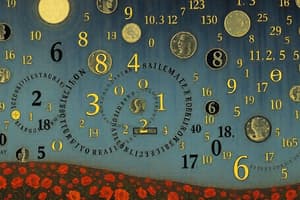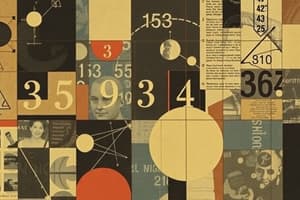Podcast
Questions and Answers
Which transformation involves flipping a geometric figure over a line?
Which transformation involves flipping a geometric figure over a line?
- Reflection (correct)
- Translation
- Rotation
- Dilation
What is the primary purpose of derivatives in calculus?
What is the primary purpose of derivatives in calculus?
- To measure the rate of change of a function (correct)
- To determine the maximum value of a function
- To find the area under a curve
- To evaluate limits
Which measure of central tendency is least affected by extreme values?
Which measure of central tendency is least affected by extreme values?
- Range
- Median (correct)
- Mean
- Mode
In probability, what does a probability of 0 indicate about an event?
In probability, what does a probability of 0 indicate about an event?
What is the first step in effective problem-solving strategies?
What is the first step in effective problem-solving strategies?
Which of the following is an example of a rational number?
Which of the following is an example of a rational number?
What is the correct order of operations in mathematics?
What is the correct order of operations in mathematics?
Which of the following best describes a linear equation?
Which of the following best describes a linear equation?
What is the definition of whole numbers?
What is the definition of whole numbers?
What does the term 'polygon' refer to in geometry?
What does the term 'polygon' refer to in geometry?
What set of numbers does the term 'complex numbers' refer to?
What set of numbers does the term 'complex numbers' refer to?
Which of the following operations involves repeated addition?
Which of the following operations involves repeated addition?
Which type of equation includes a term with a variable raised to the second degree?
Which type of equation includes a term with a variable raised to the second degree?
Flashcards
Rational Numbers
Rational Numbers
Numbers that can be expressed as a fraction p/q, where p and q are integers and q is not zero.
Irrational Numbers
Irrational Numbers
Numbers that cannot be expressed as a fraction of two integers.
Addition
Addition
The process of combining two or more numbers to find a total.
Subtraction
Subtraction
Signup and view all the flashcards
Multiplication
Multiplication
Signup and view all the flashcards
Division
Division
Signup and view all the flashcards
Variables
Variables
Signup and view all the flashcards
Inequalities
Inequalities
Signup and view all the flashcards
Volume
Volume
Signup and view all the flashcards
Surface area
Surface area
Signup and view all the flashcards
Limit of a function
Limit of a function
Signup and view all the flashcards
Derivative
Derivative
Signup and view all the flashcards
Integral
Integral
Signup and view all the flashcards
Study Notes
Fundamental Concepts
- Mathematics encompasses various subjects, including arithmetic, algebra, geometry, calculus, and statistics.
- It studies abstract concepts like numbers, shapes, and patterns.
- Mathematics is crucial in fields from engineering and science to finance and computer science.
- Mathematical reasoning relies on logic, deduction, and proof.
- Problems are presented as puzzles and challenges to foster critical thinking.
Number Systems
- Natural numbers (counting numbers): 1, 2, 3, ...
- Whole numbers: 0, 1, 2, 3, ... (including zero)
- Integers: ..., -3, -2, -1, 0, 1, 2, 3, ... (including negative whole numbers)
- Rational numbers: fractions p/q, where p and q are integers, and q ≠ 0.
- Irrational numbers: cannot be expressed as a fraction of integers, e.g., √2, π.
- Real numbers: encompass all rational and irrational numbers.
- Complex numbers: a + bi, where a and b are real numbers, and 'i' is the imaginary unit (√-1).
Arithmetic Operations
- Addition: finding the sum of two or more numbers.
- Subtraction: finding the difference between two numbers.
- Multiplication: repeated addition of a number.
- Division: splitting a number into equal parts.
- Order of operations (PEMDAS/BODMAS): Parentheses/Brackets, Exponents/Orders, Multiplication and Division (left to right), Addition and Subtraction (left to right).
Algebra
- Variables: unknown values represented by symbols (e.g., x, y).
- Equations: state the equality of two expressions.
- Inequalities: show the relationship between two expressions using symbols like <, >, ≤, ≥.
- Polynomials: expressions with variables and coefficients combined by addition, subtraction, and multiplication.
- Linear equations: form a straight line when plotted.
- Quadratic equations: have a second-degree term (x²).
Geometry
- Shapes: 2D figures (squares, triangles, circles) and 3D figures (cubes, spheres, cones, cylinders).
- Angles: formed by two rays sharing a common endpoint.
- Lines and planes: basic elements in geometry.
- Polygons: closed figures formed by straight lines.
- Area and perimeter: measurements of a 2D shape.
- Volume and surface area: measurements of a 3D shape.
- Transformations: movements of shapes (translations, rotations, reflections, dilations).
Calculus
- Limits: the value a function approaches as its input approaches a value.
- Derivatives: measure the rate of change of a function.
- Integrals: measure the area under a curve.
- Real-world applications: motion, optimization, modeling.
Statistics
- Data collection and organization.
- Measures of central tendency (mean, median, mode).
- Measures of dispersion (variance, standard deviation).
- Probability: likelihood of an event.
- Data representation: histograms, bar charts, scatter plots, etc.
- Drawing conclusions from data.
- Hypothesis testing: statistical methods to test claims about populations.
Solving Problems
- Problem-solving strategies: understanding, planning, execution, evaluation.
- Mathematics relies on logical reasoning based on data, formulas, and models.
Studying That Suits You
Use AI to generate personalized quizzes and flashcards to suit your learning preferences.
Description
Explore the essential concepts of mathematics, including various number systems and the application of mathematical reasoning. This quiz covers topics from natural numbers to complex numbers and their significance in different fields. Test your knowledge on fundamental mathematical concepts and definitions.




